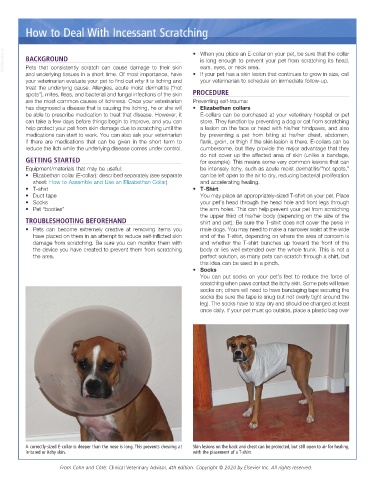Page 3199 - Cote clinical veterinary advisor dogs and cats 4th
P. 3199
How to Deal With Incessant Scratching
VetBooks.ir BACKGROUND • When you place an E-collar on your pet, be sure that the collar
is long enough to prevent your pet from scratching its head,
ears, eyes, or neck area.
Pets that consistently scratch can cause damage to their skin
and underlying tissues in a short time. Of most importance, have • If your pet has a skin lesion that continues to grow in size, call
your veterinarian evaluate your pet to find out why it is itching and your veterinarian to schedule an immediate follow-up.
treat the underlying cause. Allergies, acute moist dermatitis (“hot
spots”), mites, fleas, and bacterial and fungal infections of the skin PROCEDURE
are the most common causes of itchiness. Once your veterinarian Preventing self-trauma:
has diagnosed a disease that is causing the itching, he or she will • Elizabethan collars
be able to prescribe medication to treat that disease. However, it E-collars can be purchased at your veterinary hospital or pet
can take a few days before things begin to improve, and you can store. They function by preventing a dog or cat from scratching
help protect your pet from skin damage due to scratching until the a lesion on the face or head with his/her hindpaws, and also
medications can start to work. You can also ask your veterinarian by preventing a pet from biting at his/her chest, abdomen,
if there are medications that can be given in the short term to flank, groin, or thigh if the skin lesion is there. E-collars can be
reduce the itch while the underlying disease comes under control. cumbersome, but they provide the major advantage that they
do not cover up the affected area of skin (unlike a bandage,
GETTING STARTED for example). This means some very common lesions that can
Equipment/materials that may be useful: be intensely itchy, such as acute moist dermatitis/“hot spots,”
• Elizabethan collar (E-collar): described separately (see separate can be left open to the air to dry, reducing bacterial proliferation
sheet: How to Assemble and Use an Elizabethan Collar) and accelerating healing.
• T-shirt • T-Shirt
• Duct tape You may place an appropriately-sized T-shirt on your pet. Place
• Socks your pet’s head through the head hole and front legs through
• Pet “booties” the arm holes. This can help prevent your pet from scratching
the upper third of his/her body (depending on the size of the
TROUBLESHOOTING BEFOREHAND shirt and pet). Be sure the T-shirt does not cover the penis in
• Pets can become extremely creative at removing items you male dogs. You may need to make a narrower waist at the wide
have placed on them in an attempt to reduce self-inflicted skin end of the T-shirt, depending on where the area of concern is
damage from scratching. Be sure you can monitor them with and whether the T-shirt bunches up toward the front of the
the device you have created to prevent them from scratching body or lies well extended over the whole trunk. This is not a
the area. perfect solution, as many pets can scratch through a shirt, but
this idea can be used in a pinch.
• Socks
You can put socks on your pet’s feet to reduce the force of
scratching when paws contact the itchy skin. Some pets will leave
socks on; others will need to have bandaging tape securing the
socks (be sure the tape is snug but not overly tight around the
leg). The socks have to stay dry and should be changed at least
once daily. If your pet must go outside, place a plastic bag over
A correctly-sized E-collar is deeper than the nose is long. This prevents chewing at Skin lesions on the back and chest can be protected, but still open to air for healing,
irritated or itchy skin. with the placement of a T-shirt.
From Cohn and Côté: Clinical Veterinary Advisor, 4th edition. Copyright © 2020 by Elsevier Inc. All rights reserved.

